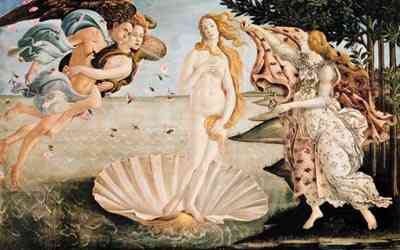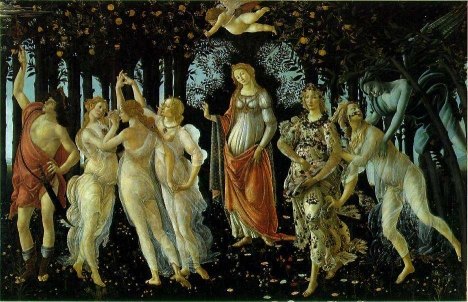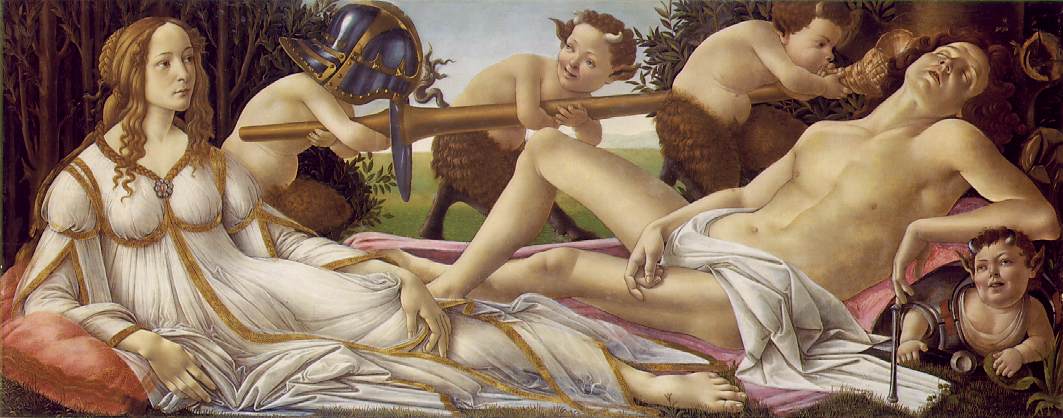|
Sandro Botticelli
(1445-1510)
Sandro Botticelli's life was not documented per se, but there is a
strong oral tradition about him, which was picked up by the early
biographer of the artists of the time, Giorgio Vasari. Lots of what is saved to our times might not be the absolute truth but it sure gives a good impression on Botticelli's life.
Amongst other things, he was said to have had a terrific
sense of humor, even if a bit of the melancholy were about him. Some even said he was neurotic. But first some facts that we can be pretty sure about.
He was bon in Florence, 1445, as Alessandro di Mariano Filipepi. His father
was a tanner (leatherworker) and relatively poor man. The nickname
"Botticelli" means "little barrel" and was originally the nickname of
Alessandro's older brother, and it also seems to have been a nickname of
the goldsmith his father first apprenticed him to. Eventually the
nickname passed on to Sandro, and it stuck.

After apprenticing to the goldsmith "Botticelli", Sandro
then continued his artistic training and working with the famous
painter Fra Filippo Lippi and the painter and engraver Antonio del Pollaiuolo. This
working relationship with an engraver may have contributed to Sandro's
strong sense and use of line in his own paintings.
It was common for the more gifted "draftsmen" of the time to be
apprenticed to goldsmiths. The goldsmith was considered to be at the top
of the guild system, along side the sculptors and architects. While
painters at this time were mostly still considered to be of the artisan,
craftsman class, having apprentice training to a goldsmith greatly
increased the painter's abilities and sense of depth, perspective, and
foreshortening, as well as the social respectablility.
This training in three dimensional sensibilities (casting and shaping of
articles in gold), would translate into an increased realism and the
magical effect of illusion in the paintings on two dimensional surfaces.
These two qualities were becoming hightly sought after by the newer
patrons to the arts -- the highly educated and sophisticated merchants
and financiers in the trading city states of Northern Italy.
The highly skilled engraving often done by the master goldsmith would
also provide invaluable training to the young painter-draftsman. In
later decades this training would often enable a painter to do his own
engravings to make prints from (as is the case of Albrecht Dürer),
thereby increasing his financial returns. This training received by
Sandro early on, and then working with an engraver afterwards (who most
likely also had goldsmith training) must have been the influence to his
use of line in his masterpieces.
 Sandro eventually set up his own workshop in the year 1470, and his
reputation soon brought him numerous commissions from the wealthy and
influencial families of Florence, amoung them, the learned, extremely
wealthy, and powerful Medici family. His association with the Medici
was a long and rewarding one. He was so well liked by the family, that
he spent much time in their presence entertaining them, and dining with
them (in association with the other famous, local intellectuals,
philosophers and poets). The family commissioned him to paint several
portraits for them, as well as the very large "allegorical" paintings
for which he has become most famous: "The Primavera - Allegory of
Spring", "The Birth of Venus" and "Pallas and the Centaur" (when returning to Florence in 1482; completed 1486).
Sandro eventually set up his own workshop in the year 1470, and his
reputation soon brought him numerous commissions from the wealthy and
influencial families of Florence, amoung them, the learned, extremely
wealthy, and powerful Medici family. His association with the Medici
was a long and rewarding one. He was so well liked by the family, that
he spent much time in their presence entertaining them, and dining with
them (in association with the other famous, local intellectuals,
philosophers and poets). The family commissioned him to paint several
portraits for them, as well as the very large "allegorical" paintings
for which he has become most famous: "The Primavera - Allegory of
Spring", "The Birth of Venus" and "Pallas and the Centaur" (when returning to Florence in 1482; completed 1486).
An altarpiece ("Adoration of the Magi" - Uffici Gallery, Florence)
painted by Sandro, in about 1475, when Sandro was about 30 years of
age,, contains the likenesses of four members of the Medici family (along with a likeness of himself,
looking back over his shoulder at the viewer). This painting also has likenesses of the Medici "Court",
including the poet-philosopher "Poliziano", who had an influence upon
Sandro's intellectual leanings.
In the year of 1481, Sandro was called upon to assist in the painting
of the walls of the Vatican's Sistine Chapel in Rome. The Youth of
Moses, Punishment of the Sons of Corah, and, Temptation of Christ, are
the contributions made by Sandro.
By about 1500 his style was getting oldfashioned in the eyes of the people of those times. So his last years weren't as successfull
as were his first. The new ideas of Michelangelo and Leonardo da Vinci were undermining his popularity.

|
Good and evil, men and women, right or wrong? Nothing can exist without the other, but
if you listen to your heart, you'll know what to choose.
(That is what comes to my mind, when I think about Botticelli's paintings.)
|
If this page has made you curious and you want to know more about Botticelli, go to Mark Hardens Site.
|

